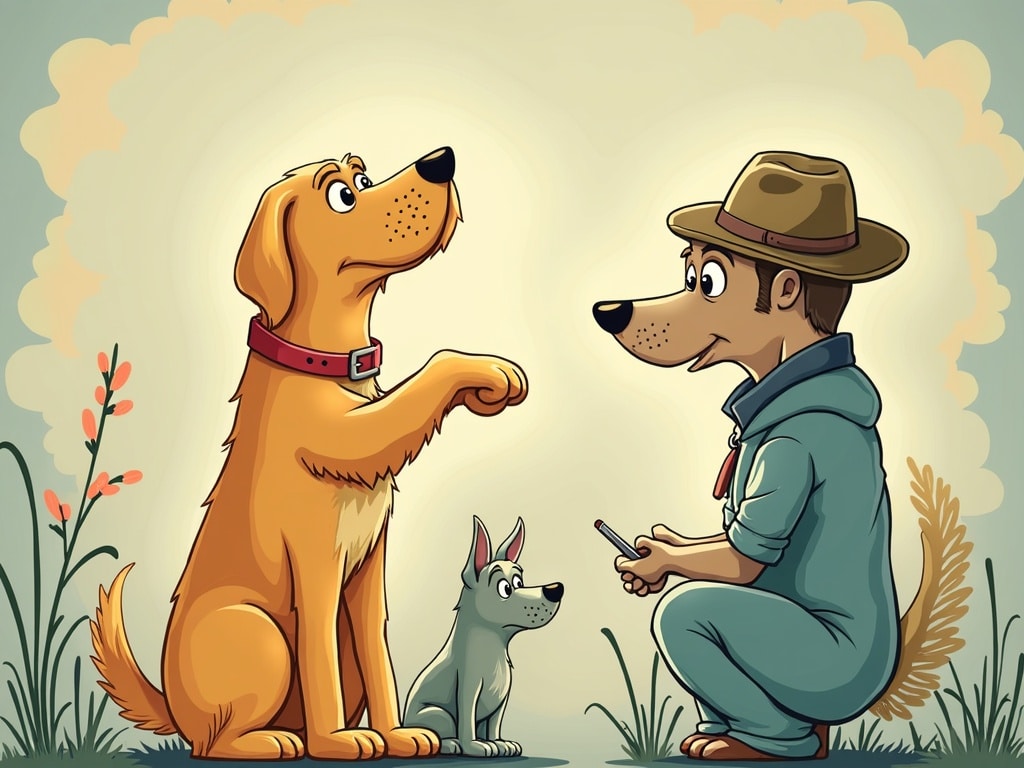
Beyond No Bark: The Quiet Command for a Calmer, Happier Dog
Imagine a serene evening at home, the only sounds are your favorite playlist and the gentle rustling of leaves outside. Suddenly, a barrage of barking shatters the peace. Sound familiar? For many dog owners, excessive barking is a common challenge, turning moments of tranquility into frustrating ordeals. But what if you could gently guide your exuberant canine companion towards a quieter, more relaxed demeanor? This is where the ‘quiet’ command comes in – a powerful tool not just for silencing the noise, but for fostering a deeper understanding and a more harmonious relationship with your dog.
More than just a simple trick, the ‘quiet’ command is a gateway to better communication, reduced anxiety, and a significantly improved quality of life for both you and your furry friend. Let’s embark on a journey to discover how to effectively teach the ‘quiet’ command, transforming your boisterous barker into a beacon of canine calm.
What is the ‘Quiet’ Command and Why is it Important?
The ‘quiet’ command is a verbal cue that teaches your dog to stop barking on command. It’s not about suppressing their natural instinct to communicate, but rather about providing them with a clear and reliable signal to cease barking when appropriate. Its importance extends far beyond simply quieting your dog.
- Improved Communication: The ‘quiet’ command establishes a clear line of communication, helping your dog understand your expectations.
- Reduced Anxiety: Excessive barking is often a sign of anxiety or stress. The ‘quiet’ command can help your dog feel more secure by providing a structured way to manage their impulses.
- Stronger Bond: Training fosters a deeper connection between you and your dog through shared learning and positive reinforcement.
- Social Harmony: A dog who knows the ‘quiet’ command is less likely to disturb neighbors, guests, or other animals, making for a more harmonious living environment.
- Increased Safety: In certain situations, such as during emergencies or encounters with strangers, the ‘quiet’ command can be crucial for ensuring your dog’s safety and the safety of others.
Ultimately, the ‘quiet’ command is an investment in your dog’s well-being and a valuable tool for creating a calmer, happier home.
Understanding the Reasons Behind Your Dog’s Barking
Before diving into training, it’s crucial to understand why your dog is barking. Barking is a natural form of canine communication, and deciphering the reasons behind it is key to addressing the issue effectively. Here are some common reasons dogs bark:
- Territorial Barking: Barking at people or animals that enter their perceived territory (e.g., the yard, the house).
- Alarm Barking: Barking in response to a perceived threat or unusual sound.
- Attention-Seeking Barking: Barking to demand attention, food, or playtime.
- Frustration Barking: Barking due to confinement, boredom, or lack of exercise.
- Compulsive Barking: Repetitive, seemingly endless barking, often stemming from anxiety or underlying issues.
- Greeting Barking: Barking excitedly when someone arrives.
- Separation Anxiety: Barking excessively when left alone.
Identifying the triggers for your dog’s barking will help you tailor your training approach and address any underlying issues that may be contributing to the behavior. For example, a dog barking out of boredom needs more exercise and mental stimulation, whereas a dog barking out of fear may need desensitization and counter-conditioning.
Preparing for ‘Quiet’ Command Training: Essential Tools and Techniques
Setting the stage for successful ‘quiet’ command training involves gathering the right tools and adopting effective techniques. Here’s what you’ll need:
- High-Value Treats: Small, delicious treats that your dog finds irresistible.
- Clicker (Optional): A clicker can be a useful tool for marking the exact moment your dog performs the desired behavior.
- Quiet Environment: Choose a quiet place with minimal distractions to start your training sessions.
- Consistency: Use the same verbal cue (Quiet) every time.
- Patience: Training takes time and patience. Don’t get discouraged by setbacks.
In addition to these tools, it’s important to adopt a positive and encouraging training style. Focus on rewarding desired behaviors rather than punishing undesirable ones. Keep training sessions short and engaging, and end on a positive note.
Step-by-Step Guide: How to Teach the ‘Quiet’ Command Effectively
Here’s a breakdown of a simple yet effective method:
- Elicit the Bark: Encourage your dog to bark. You can do this by ringing the doorbell, knocking on the door, or showing them a toy they love.
- Say Speak: As your dog starts barking, say Speak. This associates the action with a verbal cue.
- Say Quiet: Once your dog is barking, say Quiet in a calm, firm voice.
- Wait for Silence: The moment your dog stops barking, even for a split second, mark the behavior with a clicker (if using) and immediately give them a treat.
- Repeat: Practice this sequence multiple times in short sessions.
- Fade the Speak Command: As your dog becomes more familiar with the Quiet command, you can gradually fade the Speak command and simply wait for them to bark naturally before giving the Quiet command.
Be patient and consistent. It may take several sessions for your dog to fully grasp the connection between the Quiet command and the desired behavior.
Troubleshooting Common Challenges During ‘Quiet’ Command Training
Training isn’t always smooth sailing. Here’s how to navigate common hurdles:
- Dog Doesn’t Stop Barking: If your dog continues to bark after you say Quiet, try distracting them with a toy or treat, then repeat the command when they stop. If they still don’t respond, you may need to lower the intensity of the barking trigger or restart steps.
- Dog Gets Too Excited: If your dog gets overly excited during training, take a break and try again later. Keep sessions short and use a calm, reassuring tone of voice.
- Dog Doesn’t Generalize: Your dog may understand the Quiet command in one environment (e.g., the living room) but not in another (e.g., the park). This is common. See our section on Generalization below.
- Inconsistent Results: Make sure everyone in the household is using the same command and training techniques. Consistency is key.
Remember to stay patient and positive. If you encounter significant challenges, consider consulting a professional dog trainer.
Positive Reinforcement: Rewarding Success and Maintaining Motivation

Positive reinforcement is the cornerstone of effective dog training. It involves rewarding desired behaviors to increase the likelihood of them being repeated. When teaching the ‘quiet’ command, positive reinforcement can take many forms:
- Treats: High-value treats are a powerful motivator, especially in the early stages of training.
- Praise: Verbal praise, such as Good quiet! or Well done!, can be highly rewarding for many dogs.
- Toys: A favorite toy can be used as a reward for successfully performing the ‘quiet’ command.
- Attention: A brief cuddle or playful interaction can also be a rewarding experience.
The key is to find what motivates your dog and use it consistently to reinforce their understanding of the ‘quiet’ command. Vary your rewards to keep things interesting and maintain your dog’s enthusiasm.
Once your dog reliably responds to the ‘quiet’ command, you can gradually reduce the frequency of treats and rely more on praise and other forms of positive reinforcement.
Generalization: Using the ‘Quiet’ Command in Different Environments
Once your dog understands the ‘quiet’ command in a controlled environment, it’s time to generalize the behavior to different locations and situations. This means practicing the command in a variety of settings, such as:
- Different Rooms in the House: Practice the command in each room of your home.
- The Backyard: Extend the training to your backyard.
- The Park: Practice in a less controlled environment.
- On Walks: Incorporate the command into your daily walks.
- Around Other People and Animals: Gradually introduce distractions to test your dog’s focus.
As you move to new environments, start with low-distraction settings and gradually increase the level of distractions. Remember to be patient and consistent, and reward your dog for successfully performing the ‘quiet’ command in each new situation. If your dog struggles in a particular environment, go back a step and practice in a less challenging setting.
When to Seek Professional Help: Addressing Excessive Barking Issues
While the ‘quiet’ command can be highly effective, some dogs may require professional help to address excessive barking issues. Consider seeking the guidance of a certified dog trainer or veterinary behaviorist if:
- The Barking is Compulsive: If your dog’s barking is repetitive and seemingly endless, it may be a sign of an underlying anxiety disorder.
- The Barking is Linked to Aggression: If your dog’s barking is accompanied by aggressive behaviors, such as growling or snapping, consult a professional immediately.
- The Barking is Disrupting Your Life: If your dog’s barking is causing significant stress or disruption to your life, don’t hesitate to seek professional help.
- You’ve Tried Everything Else: If you’ve tried various training techniques without success, a professional can provide personalized guidance and support.
A qualified professional can assess your dog’s behavior, identify the underlying causes of the barking, and develop a tailored training plan to address the issue effectively.
Beyond the ‘Quiet’ Command: Complementary Training Techniques
While the ‘quiet’ command is a valuable tool, it’s often most effective when combined with other training techniques that promote calmness and self-control. Here are a few complementary techniques to consider:
- Leave It: This command teaches your dog to ignore temptations, such as food or toys, which can help reduce reactivity and barking.
- Stay: The ‘stay’ command encourages your dog to remain in a specific position, promoting calmness and focus.
- Relaxation Protocol: This technique involves teaching your dog to relax on cue, which can be helpful for managing anxiety and reducing barking.
- Desensitization and Counter-Conditioning: These techniques involve gradually exposing your dog to barking triggers while associating them with positive experiences, such as treats or praise.
Check this resource: [Beyond Quiet: A Holistic Approach to Stop Dog Barking for Attention</a>]
Maintaining a Calm Environment: Long-Term Strategies for a Happier Dog
Teaching the ‘quiet’ command is just the first step. To create a truly calmer and happier dog, it’s essential to implement long-term strategies that support their overall well-being and reduce the likelihood of excessive barking. Here are a few tips:
- Provide Adequate Exercise: Regular physical exercise helps burn off excess energy and reduce boredom, which can contribute to barking.
- Offer Mental Stimulation: Puzzle toys, interactive games, and training sessions can keep your dog mentally stimulated and prevent boredom-related barking.
- Create a Safe and Comfortable Space: Ensure your dog has a quiet place to retreat to when they feel overwhelmed or anxious.
- Establish a Consistent Routine: Dogs thrive on routine. A predictable schedule for feeding, exercise, and rest can help reduce anxiety and promote calm behavior.
- Manage Stress Triggers: Identify and minimize exposure to triggers that cause your dog to bark.
The journey to a quieter, calmer dog is a rewarding one, filled with opportunities to deepen your connection and improve their overall well-being. By understanding the reasons behind your dog’s barking, employing effective training techniques, and providing a supportive environment, you can transform your boisterous barker into a serene and contented companion. So, take a deep breath, gather your treats, and embark on this exciting adventure. Your ears – and your neighbors – will thank you!

